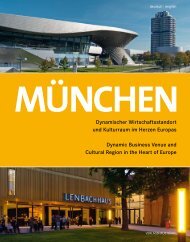München - Dynamischer Wirtschaftsstandort und Kulturraum im Herzen Europas
You also want an ePaper? Increase the reach of your titles
YUMPU automatically turns print PDFs into web optimized ePapers that Google loves.
nachhaltige Stadtgestalt gesehen werden muss. Sicher,<br />
der Gebrauchswert verändert sich meist mit dem<br />
gesellschaftlichen Wandel, aber bringt dies zwangsläufig<br />
einen Wertewandel <strong>im</strong> Hinblick auf die Architektur<br />
mit sich?<br />
Qualität für die Stadt kann nur durch einen intensiven<br />
Dialog über die Stadtbaukultur entstehen. Dazu bedarf<br />
es Raum für kulturelle Auseinandersetzung sowie<br />
Zeit, dies den einzelnen Projekten angedeihen zu lassen.<br />
Darüber hinaus braucht es Akteure <strong>und</strong> Partner<br />
in den Projekten, die gewillt sind, sich dieser Diskussion<br />
zu stellen.<br />
Strategien der<br />
Qualitätssicherung<br />
Jeder Blick auf die Stadt <strong>und</strong> ihre Stadtbaukultur offenbart<br />
uns zweierlei: ein Beibehalten von Strukturen<br />
<strong>und</strong> Überformungen, die selbst in ihren Fragmenten<br />
noch lesbar bleiben <strong>und</strong> eine Dialektik zwischen neuerer<br />
<strong>und</strong> älterer Formensprache, die als produktiver<br />
Impuls den kontinuierlichen Wandel des Stadtbildes<br />
best<strong>im</strong>men. Dies kann gerade in <strong>München</strong> besonders<br />
gut erfahren werden. Trotz der starken Zerstörung <strong>im</strong><br />
Krieg gelang es der Stadt ihren Charakter <strong>und</strong> ihre<br />
Identität zu wahren. Diese Hartnäckigkeit der inneren<br />
Bindung an die überlieferten Bilder <strong>und</strong> das durchaus<br />
widersprüchliche Verhältnis der Stadt zu diesem inneren<br />
Panorama gehen einher mit einem ausgeprägten<br />
Beharrungsvermögen, einem „Mia san Mia“ ihrer tradierten<br />
Bauformen. Da zeitgleich in schnellem Tempo<br />
an den unterschiedlichsten Stellen in der Stadt vieles<br />
neu gebaut wird, bedeutet dies Freiheit <strong>und</strong> Fessel<br />
zugleich, denn die Stadt leistet sich den Luxus, nicht<br />
jeder Mode hinterher zu hechten. Trotz der Forderung<br />
nach innovativen Konzepten ermöglicht die Stadtgesellschaft<br />
Raum für Kontinuität <strong>und</strong> Reflexion. <strong>München</strong><br />
hat gerade begonnen, sich aufmerksam seiner<br />
Nachkriegsmoderne zu widmen <strong>und</strong> der Frage nachzugehen,<br />
welche Merkmale <strong>und</strong> stadtgestalterischen<br />
Vorgaben von damals bewahrt werden sollen. Parallel<br />
entsteht ein Dialog über neue stadtgestalterische Regeln,<br />
die den Entwurfsprozess begleiten sollen. Viele<br />
Wettbewerbsverfahren <strong>und</strong> Beratergremien sichern<br />
die städtebaulichen <strong>und</strong> architektonischen Qualitäten<br />
in den einzelnen Projekten.<br />
Quality for the city can only be achieved by means of<br />
intense dialogue about its building culture. For this to<br />
take place there must be space for cultural debate<br />
and t<strong>im</strong>e to allow that debate to have an effect on the<br />
individual projects. Furthermore, there must be participants<br />
and partners in the projects that are willing<br />
to get involved in this discussion.<br />
Quality assurance<br />
strategies<br />
Every glance at the city and its building culture shows<br />
us two things: a retention of structures and remodellings<br />
that remain readable, even in their fragments, and<br />
a dialectic between younger and older styles that is a<br />
productive <strong>im</strong>pulse determining the continuous progress<br />
of the cityscape. This can be seen particularly<br />
well in Munich. Despite the extensive damage sustained<br />
in the war, the city managed to retail its character<br />
and identity. This tenacity of internal attachment<br />
to the traditional look, and the city’s ambivalent relationship<br />
to this internal panorama are accompanied<br />
by a distinctive inertia, a Bavarian sense of oneness<br />
(“Mia san Mia”) with regard to its traditional building<br />
forms. As many new constructions are being built fast<br />
and s<strong>im</strong>ultaneously at the most varied of locations in<br />
the city, this is both a freedom and a fetlock, because<br />
the city allows itself the luxury of not chasing every<br />
fad. Despite the calls for innovative concepts, the urban<br />
society enables space to be made for continuity<br />
and reflection. Munich has just begun to pay attention<br />
to its post-war modernity and to pursue the question<br />
of which features and urban planning requirements<br />
from the past should be preserved. Parallel to this a<br />
dialogue about new urban planning rules designed to<br />
accompany the design process is arising. Many calls<br />
for tender and advisory committees ensure that the<br />
urban planning and architectural qualities are upheld<br />
in the individual projects.<br />
So these are projects that know how to link the practical<br />
value to the design and aesthetic worth, projects<br />
that make it clear that beauty can also be a profo<strong>und</strong>ly<br />
sustainable criterion. Only if the projects are coherent<br />
within themselves and at the same t<strong>im</strong>e able to give<br />
the place where they are being realised a new <strong>im</strong>pulse<br />
are they integrated projects.<br />
74 Baukultur




